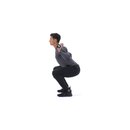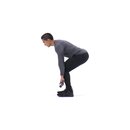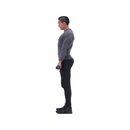I'm a big fan of the idea that less is more, but not less is easier. Because of this, I like to sometimes avoid the tedium of isolation exercises—which take up a lot of gym time while focusing on each muscle group, one by one—and, instead, focus my routine on six compound movements, using heavy weights and hitting every muscle group along the way.
In general, compound exercises utilize multiple joints with free weights. This means maximum muscle recruitment, high nervous-system activation, and more stimulus for growth, whether you're a beginner or advanced lifter.

You Can Slug Some Heavy Iron With A Handful Of Compound Exercises And Get The Same (Or Better) Results.
Compound exercises are not designed to isolate a muscle, but simply to work as much muscle as possible—from multiple body parts—as efficiently as possible!
Six Basic Compound Exercises
1. Horizontal Push Compound Exercises
Horizontal pushing exercises comprise basic bench presses and their variations, including barbell and dumbbell presses, parallel bar dips, and even push-ups.
Presses with barbells and dumbbells will, of course, work your pecs, but also your triceps and delts, and even your traps and back as secondary muscle groups.
2. Horizontal Pull Compound Exercises
Horizontal pulling exercises include bent-over rows, barbell rows, basic cable rows, and their many varieties.
These exercises pretty much work all of the muscle groups in your back, but also hit the biceps and abs!
3. Vertical Push Compound Exercises
Vertical pushing exercises cover the shoulder press (military press) and its variations—including barbell presses, single-arm dumbbell presses, double-arm dumbbell presses, lateral and front raises, and more.
These compound movements help shoulder development, as well as the traps and triceps in supporting roles.
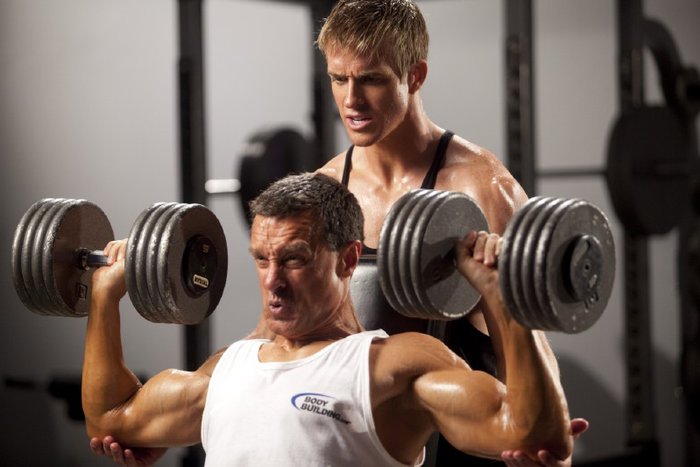
Vertical Pushes Will Help Shoulder Development As Well As The Traps.
4. Vertical Pull Compound Exercises
Vertical pulling exercises include pull-ups, chin-ups, and lat pull-downs.
These will knock out muscle groups in your back, specifically the lats, rhomboids, and teres major, but they'll also give a total burn to biceps, triceps, and abs along the way.
As a perk, additional pulling volume can help clear up some nagging shoulder issues—but for really bad shoulders, it's better to stick with more of the horizontal pulls such as rows, as moving the arms overhead can aggravate many shoulder injuries.
5. Hip-Dominant Compound Exercises
The hip-dominant category includes lower-body exercises that involve more of the glute and hamstring area than the quads. There are bent-leg and straight-leg options for hip dominant exercises.
The bent-leg option is preferable for building your glutes, which are the strongest muscle and help to ramp up almost every lower-body lift.
Some of the staple movements for the bent-leg hip-dominant category are deadlifts, lunges, step-ups, and high foot placement leg presses.
The straight-leg options (still bent, but at only 10-15 degrees) place an emphasis on the hamstring muscle belly in exercises such as the Romanian deadlift.
6. Quad-Dominant Compound Exercises
The best quad-dominant movements include squats, front squats, narrow leg presses, and lunges.
These focus on your quads but offer a huge boost in anabolic hormones that leads to all-around body growth.
Because of this, I offer a motto: Squat heavy, squat often—and all of your muscle groups will thank you.
Hip Dominant Vs. Quad Dominant
Some exercises can be either hip dominant or quad dominant, depending on form.
A squat, for example, can be done hip dominant with a low bar, feet wide, and hips back, or it can be done quad dominant with a bar up high and feet at shoulder width.
Putting These Movements Together
Going heavy with exercises from these six categories, you'll build overall body mass, while individual body parts will get enough of what they need for their own growth, as well.
The traps, for instance, should get plenty of work with the pulling variations and the overhead presses, so you don't need a trap-focused exercise! The same goes for the arms, which will get plenty of work by association, instead of isolation.
Here's a great program for putting these basic compound movements together and kicking some serious mass.
Upper-Lower Split
The upper-lower split (ULS) is a great way to counter the demands of the cardiovascular system that happen when using large upper-body and lower-body muscle groups in succession.
You don't need to go crazy with the number of movements. Doing 3-5 exercises for each session is plenty, limiting the total number of sets to about 20-25.
Upper/Lower Routine Example

BodyFit
$6.99/month- 2,500+ expert-created single workouts
- 3,500+ how-to exercise videos
- Detailed workout instruction
- Step-by-step workout tips
- Training at gym or at home
- Access to Workout Plans
- Access to Bodyfit App
- Store Discounts
Already have a Bodybuilding.com account with BodyFit? Sign In

What comes with BodyFit?

- Instructional Videos
Don't risk doing a workout improperly! Avoid injury and keep your form in check with in-depth instructional videos.

- How-to Images
View our enormous library of workout photos and see exactly how each exercise should be done before you give it a shot.

- Step-by-Step Instructions
Quickly read through our step-by-step directions to ensure you're doing each workout correctly the first time, every time.
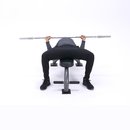
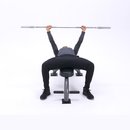

BodyFit
$6.99/month- 2,500+ expert-created single workouts
- 3,500+ how-to exercise videos
- Detailed workout instruction
- Step-by-step workout tips
- Training at gym or at home
- Access to Workout Plans
- Access to Bodyfit App
- Store Discounts
Already have a Bodybuilding.com account with BodyFit? Sign In

What comes with BodyFit?

- Instructional Videos
Don't risk doing a workout improperly! Avoid injury and keep your form in check with in-depth instructional videos.

- How-to Images
View our enormous library of workout photos and see exactly how each exercise should be done before you give it a shot.

- Step-by-Step Instructions
Quickly read through our step-by-step directions to ensure you're doing each workout correctly the first time, every time.

BodyFit
$6.99/month- 2,500+ expert-created single workouts
- 3,500+ how-to exercise videos
- Detailed workout instruction
- Step-by-step workout tips
- Training at gym or at home
- Access to Workout Plans
- Access to Bodyfit App
- Store Discounts
Already have a Bodybuilding.com account with BodyFit? Sign In

What comes with BodyFit?

- Instructional Videos
Don't risk doing a workout improperly! Avoid injury and keep your form in check with in-depth instructional videos.

- How-to Images
View our enormous library of workout photos and see exactly how each exercise should be done before you give it a shot.

- Step-by-Step Instructions
Quickly read through our step-by-step directions to ensure you're doing each workout correctly the first time, every time.
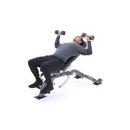
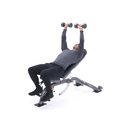

BodyFit
$6.99/month- 2,500+ expert-created single workouts
- 3,500+ how-to exercise videos
- Detailed workout instruction
- Step-by-step workout tips
- Training at gym or at home
- Access to Workout Plans
- Access to Bodyfit App
- Store Discounts
Already have a Bodybuilding.com account with BodyFit? Sign In

What comes with BodyFit?

- Instructional Videos
Don't risk doing a workout improperly! Avoid injury and keep your form in check with in-depth instructional videos.

- How-to Images
View our enormous library of workout photos and see exactly how each exercise should be done before you give it a shot.

- Step-by-Step Instructions
Quickly read through our step-by-step directions to ensure you're doing each workout correctly the first time, every time.
In an upper-lower split such as this, there are 7 total sets apiece for horizontal pushing and pulling, and vertical pushing and pulling—totaling 28 sets of upper-body work for the week. The lower body will also have a total of 28 sets, equally divided between hip- and quad-dominant compound exercises.
Each workout by itself might not seem like much, but the overall effect of consistently attacking these compound exercises will be a full-body strength and mass buildup!




